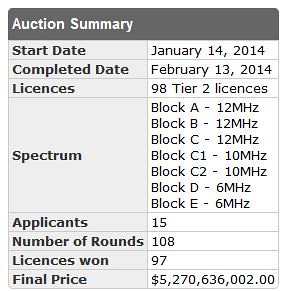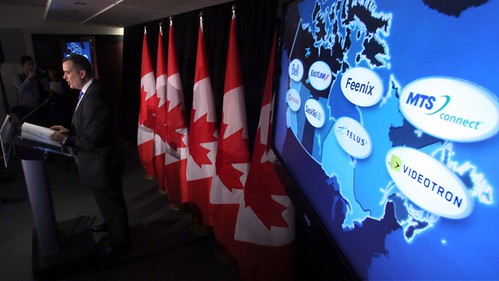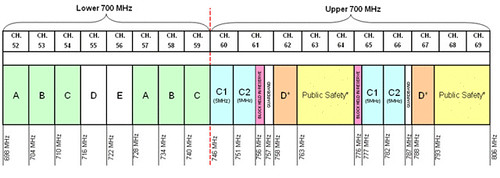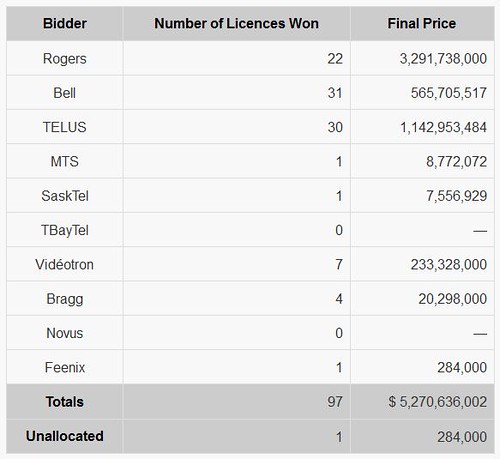The Canadian government’s 700 MHz auction is done. The country’s three dominate players, Rogers Communications, Telus and Bell Canada, all gained spectrum licenses across most of the country, while most regions witnessed just one bidder outside the big three.
Canada, which has among the highest rates for cell phone useage, hoped to encourage more competition. Now there will be four carriers in each region. Vidéotron scored wireless licences in Ontario, B.C. and Alberta, creating potential for it to become Canada’s fourth carrier. EastLink, MTS, Feenix and Sasktel also bought spectrum. Novus and TBayTel were shut out.
 Industry Canada, which conducted the auction, tried to put a positive spin on the outcome, notes RCR Wireless, proclaiming: “First and foremost, at least four wireless players in every region of the country now hold high-quality spectrum.”
Industry Canada, which conducted the auction, tried to put a positive spin on the outcome, notes RCR Wireless, proclaiming: “First and foremost, at least four wireless players in every region of the country now hold high-quality spectrum.”
The auction included 108 rounds of bidding from Jan. 14 though Feb. 13. A total of 97 licenses were awarded to eight companies, with total bids nearing $4.8 billion. By comparision, Canada’s 2008 auction of licenses in the 1.7/2.1 GHz (AWS) band generated $4.25 billion in revenues and the USA’s 700 MHz auction generated $19 billion.
Licenses up for bid included 12-megahertz paired blocks (blocks A, B, and C); 10-megahertz paired blocks (blocks C1 and C2); and six-megahertz unpaired blocks (blocks D and E).
Rogers spent nearly $3 billion for 22 A-, B- and C-Block spectrum licenses covering nearly 33.4 million potential customers and picked up two licenses across most regions, giving it access to 24 megahertz of spectrum in the 700 MHz band.
Telus spent $1 billion in total winning bids for 16 paired and 14 unpaired licenses covering nearly 33.5 million pops. The paired licenses included a mix of both 12-megahertz and 10-megahertz licenses.
Bell Canada spent nearly $511 million on 17 paired and 14 unpaired licenses covering nearly 33.5 million pops, with a similar mix of 12-megahertz and 10-megahertz paired licenses to that of Telus.
Both Telus and Bell Canada operate with a network sharing arrangement allowing them to offer services in each other’s regions. Bell Canada focused in Eastern Canada and Telus focused in Western Canada.
Regional operator Videotron acquired seven paired, 10-megahertz spectrum licenses for $210 million covering 28 million pops. Those licenses covered Quebec, Ontario, Alberta and British Columbia.
The 700 MHz band in Canada has been coordinated with the 700 MHz band in the USA, which was auctioned off in 2008 and netted some $19 billion for the US Treasury.
While most spectrum assignments are coordinated between the United States and Canada to facilitate roaming, the 2.6 GHz band is not. Canada has adopted the European band plan on the 2.6 GHz band which assigns paired spectrum on 140 MHz and unpaired spectrum in the middle 50 MHz. Sprint, China Mobile, and Softbank have adopted another spectrum plan that essentially devotes the entire 190 MHz of the 2.6 GHz band to Time Division Duplex (TDD), using unpaired frequencies.
Related Dailywireless articles include; Canada’s 700 MHz Auction to Stimulate Competition, Verizon Eyes Canada’s Spectrum Auction, UK Auction Winners Announced, Money Talks in 2008 700MHz Auction, FCC Orders Lower 700 MHz Interoperability, Dish: Lower 700MHz Power Ups Speculation, AT&T and Verizon: No 700 MHz Interoperability For You!, AT&T Competitors: No 700MHz Roaming, FCC Announces H Block Auction, AT&T Buying Leap Wireless (Cricket), Dish and Sprint Battle over PCS band Extension, FCC Approves 2.3 GHz for AT&T, MetroPCS Merges with T-Mobile USA
Posted on Fri, 21 Feb 2014 17:46:59 +0000 at http://www.dailywireless.org/2014/02/21/...tion-done/
Comments: http://www.dailywireless.org/2014/02/21/.../#comments





